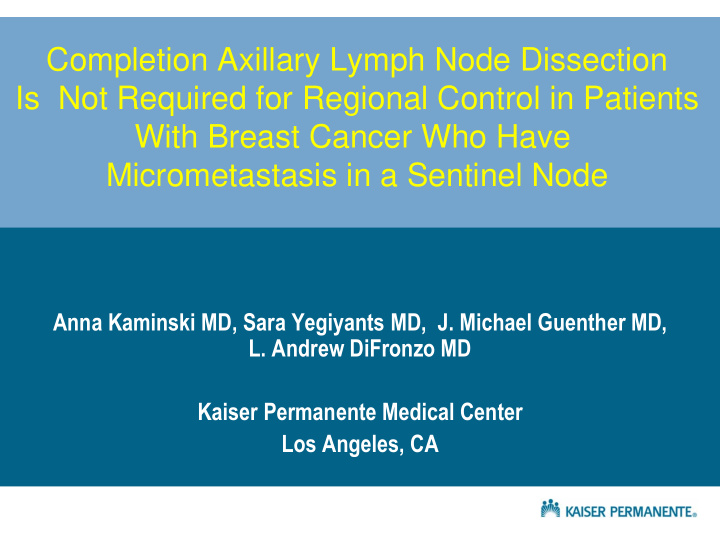



Completion Axillary Lymph Node Dissection Is Not Required for Regional Control in Patients With Breast Cancer Who Have Micrometastasis in a Sentinel Node Anna Kaminski MD, Sara Yegiyants MD, J. Michael Guenther MD, L. Andrew DiFronzo MD Kaiser Permanente Medical Center Los Angeles, CA
Introduction • Sentinel Node Biopsy (SLNBx) • Increases sensitivity of surgical staging • Avoids ALND when negative • Safe
Introduction • ALND • Completion ALND is standard of care • ? In patients with cellular micrometastasis • Complications • Regional control? • Survival benefit?
Aim of Study • Is completion ALND needed for regional control in patients with metastatic disease in SLN?
Methods • Retrospective (1997 - 2005) • Patients underwent breast conserving surgery with positive SLN • Axillary observation per patient and clinician preference
Methods Variables • Locoregional and distant recurrence • Survival • Treatment patterns • Clinicopathologic variables • Histologic subtype • Stage • Tumor grade • Sentinel node characteristics • Macromets (>2mm) • Micromets (<2mm) • Cellular (detected by IHC only)
Results • Fifty patients with a positive SLN who underwent axillary observation were identified • Three patients were lost to follow-up and excluded from analysis • Patients did not undergo axillary radiation
Patient Characteristics Total no. of patients 47 Age Mean 57 years Range 29 - 83
Tumor Characteristics Histologic Subtype Invasive ductal 33 (70%) Invasive lobular 7(15%) Other 7(15%) Initial tumor stage T1a 1 (2.1%) Mean tumor size – 1.9 cm T1b 8 (17%) Range – 0.4 to 5 cm T1c 22 (47%) T2 16 (34%) Nuclear grade* 1 7 (15%) 2 25(53%) 3 11 (23%) * Not available for all patients
Tumor Characteristics ER Positive 43 (91%) Negative 4 (8.5%) PR* Positive 22 Negative 4 Her2Neu* Positive 1 Negative 13 * Not available for all patients
Sentinel Lymph Node Characteristics No. of SLNs identified Median 2 Range 1-9 No. of positive SLNs Median 1 Range 1-2 Total size of SLN metastasis Median 2 mm Range 0.2-20 mm Type of SLN metastasis Macro ( ≥ 2 mm) 14 (30%) Micro( ≤ 2 mm) 33 (70%) Cellular 17/33(51%)
Treatment Patterns All patients underwent whole breast irradiation, and 43 patients (92%) received systemic therapy
Follow Up • The mean duration of follow-up was 54 months (median 50, range 6 - 113) • The mean duration of follow-up for macrometastasis was 49 months (median 46, range 24 – 110)
Survival, Recurrence, and Distant Metastasis • One death • One patient (2.1%) developed an axillary recurrence • 4mm metastasis in the SLN. ALND was performed 28 months after the initial operation, and 13 of 21 nodes were involved by tumor • Developed distant metastasis
Conclusions • ALND is not necessary for regional control in patients with micrometastatic disease • Even in patients with macrometastatic disease recurrence is low 1/14 (7%) with a mean follow up of 49 months • Additional studies will be necessary to further define which patients can avoid and which patients would benefit from axillary dissection
Recommend
More recommend